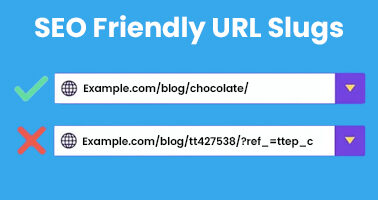SEO-Friendly URLs ? You’ve probably clicked on a URL that looked something like this:
*example.com/p=12345&category=undefined&ref=homepage*
Confusing, right? Now compare that to:
example.com/seo-friendly-urls
Which one would you rather click? Which one do you think ranks better?
That’s the power of an SEO-friendly URL – and the good news is, creating them is easier than you think. Let’s break it down.

Why SEO-Friendly URLs Matter More Than You Realize
Google’s John Mueller has said that URLs are a “small ranking factor,” but their real power comes from how they affect user behavior:
✔ Better click-through rates – Clear URLs get more clicks
✔ Improved readability – Both for users and search engines
✔ Easier sharing – People actually remember good URLs
✔ Keyword reinforcement – Another place to include your target terms
Here’s a simple trick: Try reading your URL out loud. If it doesn’t make sense or is hard to say, it’s probably not SEO-friendly.
The 5 Rules of Perfect SEO-Friendly URLs
1. Keep It Short and Sweet
- Ideal length: 3-5 words
- Maximum: About 60 characters
- Remove all unnecessary parameters
Bad: example.com/blog/post?id=123&category=seo&source=newsletter
Good:example.com/seo-friendly-urls
2. Use Hyphens to Separate Words
Google recommends hyphens (-) as word separators, not underscores (_).
Why?
- example.com/seo_friendly_urls (Google sees “seofriendlyurls”)
- example.com/seo-friendly-urls (Google sees
3. Include Your Target Keyword (But Naturally)
Your main keyword should appear, but don’t force it.
Too forced: example.com/best-seo-friendly-url-tips-2025
Just right: example.com/seo-url-best-practices
4. Stick to Lowercase Letters
Some servers treat “Example.com/SEO” and “example.com/seo” as different pages, which can cause duplicate content issues
5. Remove Stop Words When Possible
Words like “a,” “the,” and “and” can usually be removed without losing meaning.
Before: example.com/how-to-create-an-seo-friendly-url
After: example.com/create-seo-friendly-url
Common URL Mistakes That Hurt Your SEO
We’ve seen these errors on otherwise well-optimized sites
❌ Using dates unnecessarily
Unless your content is truly time-sensitive, avoid:
example.com/seo-tips-05-2024
❌ Overusing categories
example.com/blog/seo/tips/urls/friendly/optimization (too deep!)
❌ Session IDs in URLs
example.com/product?sessionid=ABC123
❌ Uppercase letters
Which can cause canonicalization issues
How to Check and Fix Existing URLs
You might be wondering how to audit your current URLs. Here’s a simple process:
- Run a site audit using Screaming Frog or Google Search Console
- Look for problematic URLs (long, parameter-heavy, etc.)
- Set up 301 redirects when changing URLs
- Update internal links to point to the new versions
As Moz’s URL SEO guide explains, consistency is key – once you set a URL structure, stick with it.
Pro Tips From the Trenches
- Match URLs to title tags when possible (creates consistency)
- Avoid changing URLs unless absolutely necessary
- Use canonical tags if you must keep non-SEO-friendly URLs
- Test different URL structures for high-value pages
Google’s URL guidelines recommend keeping URLs “simple, descriptive, and consistent” – words to live by.
Putting It All Together
Remember:
✔ Short, descriptive URLs perform best
✔ Hyphens beat underscores every time
✔ Include keywords naturally
✔ Consistency matters more than perfection
Want to check your URLs instantly? Try our free SEO-Friendly URL Validator – it takes seconds and could improve your rankings immediately.
Q: How long should my URLs be?
A: Aim for 50-60 characters max, but prioritize clarity over strict length.
Q: Should I change old URLs that aren’t optimized?
A: Only if you can properly redirect them – otherwise, you might lose existing rankings.
Q: Do keywords in URLs help rankings?
A: They’re a small factor, but more importantly, they help users understand your content
.
Got a URL you’re not sure about? Test it with our free validator and see how it stacks up!
